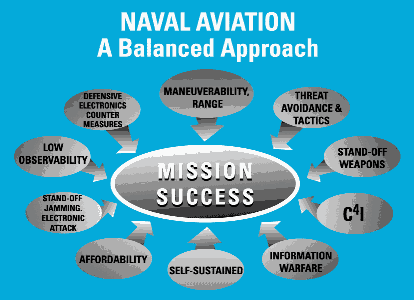SYSTEM OVERVIEW
Naval Aviation has long been at the forefront of U.S. power-projection
capabilities. As a carrier and its air wing or an amphibious ready group
deploy, they represent a unique forward presence that provides a broad spectrum of warfighting capabilities.
By leveraging technology, innovative tactics, and highly trained people,
these forces provide the National Command Authority with a wide range of
crisis-management and combat capabilities.
unique forward presence that provides a broad spectrum of warfighting capabilities.
By leveraging technology, innovative tactics, and highly trained people,
these forces provide the National Command Authority with a wide range of
crisis-management and combat capabilities.
 As Naval Aviation
moves into the 21st century, we will continue to use a systems approach
to improve its capabilities. The foundation of this methodology is making
proper use of Naval Aviation's most important asset - its people. Our aircrews
are able to perform a broad spectrum of missions, and our support personnel
are the bedrock of the entire Naval Aviation organization. Naval Aviation
must continue to emphasize consistency, education, and leadership in its
manpower policies in order to sustain its standard of excellence and the
morale of its people. This leadership challenge also includes fostering
an understanding of modern warfare and applying naval operational concepts
across a range of scenarios.
As Naval Aviation
moves into the 21st century, we will continue to use a systems approach
to improve its capabilities. The foundation of this methodology is making
proper use of Naval Aviation's most important asset - its people. Our aircrews
are able to perform a broad spectrum of missions, and our support personnel
are the bedrock of the entire Naval Aviation organization. Naval Aviation
must continue to emphasize consistency, education, and leadership in its
manpower policies in order to sustain its standard of excellence and the
morale of its people. This leadership challenge also includes fostering
an understanding of modern warfare and applying naval operational concepts
across a range of scenarios.
The systems approach also entails a balance of affordable, multimission
platforms, systems, and weapons. New aircraft and technology will provide
Naval Aviation with greater lethality, increased reliability, and enhanced
survivability. Reducing the number of aircraft types and transitioning
from single-mission to multimission platforms will provide Naval Aviation
with greater mission flexibility and cost-effective maintenance, as well
as a flexible logistics support base. 
Finally, balance means pursuing the right mix of low observability,
countermeasures, threat avoidance, tactics, and standoff weapons. There
is no one technology or attribute that can meet all mission requirements.
Taking a balanced approach will allow Naval Aviation to fulfill its mission
requirements even when one element has a diminished effectiveness due to
an enemy's capabilities.
All told, this systems approach to improvement will ensure that Naval
Aviation
continues to respond rapidly, credibly, and flexibly to future contingencies.
 System
Overview
System
Overview  Safety
Safety  Affordable
Avionics
Affordable
Avionics  C4/ISR
C4/ISR  Aircraft
Carriers
Aircraft
Carriers  Carrier
Air Wings
Carrier
Air Wings
 F-14
Tomcat
F-14
Tomcat  F/A-18
Hornet
F/A-18
Hornet  Joint
Strike Fighter
Joint
Strike Fighter  Airborne
Reconnaissance Vision
Airborne
Reconnaissance Vision  E-2C
Hawkeye
E-2C
Hawkeye  S-3B
Viking
S-3B
Viking
 ES-3A
Shadow
ES-3A
Shadow  Common
Support Aircraft
Common
Support Aircraft  EA-6B
Prowler
EA-6B
Prowler  Helicopter
Master Plan
Helicopter
Master Plan
 Marine
Corps Fixed-Wing Aircraft
Marine
Corps Fixed-Wing Aircraft  Marine
Corps Rotary-Wing Aircraft
Marine
Corps Rotary-Wing Aircraft  P-3C
Orion
P-3C
Orion  EP-3E
Aries II
EP-3E
Aries II  E-6A/B
Mercury
E-6A/B
Mercury
 Air-to-Air
Missiles
Air-to-Air
Missiles  Air-to-Ground
Weapons
Air-to-Ground
Weapons  Air-to-Subsurface
Weapons
Air-to-Subsurface
Weapons  Naval
Reserve Aviation
Naval
Reserve Aviation  Logistics
Airlift
Logistics
Airlift
 Training
Aircraft
Training
Aircraft  Aircrew
Training
Aircrew
Training  Aviation
Specialized Skills Training
Aviation
Specialized Skills Training  Logistics
Logistics  Expeditionary
Airfields
Expeditionary
Airfields
 Air
Traffic Control
Air
Traffic Control  Ranges
and Airfields
Ranges
and Airfields


 As Naval Aviation
moves into the 21st century, we will continue to use a systems approach
to improve its capabilities. The foundation of this methodology is making
proper use of Naval Aviation's most important asset - its people. Our aircrews
are able to perform a broad spectrum of missions, and our support personnel
are the bedrock of the entire Naval Aviation organization. Naval Aviation
must continue to emphasize consistency, education, and leadership in its
manpower policies in order to sustain its standard of excellence and the
morale of its people. This leadership challenge also includes fostering
an understanding of modern warfare and applying naval operational concepts
across a range of scenarios.
As Naval Aviation
moves into the 21st century, we will continue to use a systems approach
to improve its capabilities. The foundation of this methodology is making
proper use of Naval Aviation's most important asset - its people. Our aircrews
are able to perform a broad spectrum of missions, and our support personnel
are the bedrock of the entire Naval Aviation organization. Naval Aviation
must continue to emphasize consistency, education, and leadership in its
manpower policies in order to sustain its standard of excellence and the
morale of its people. This leadership challenge also includes fostering
an understanding of modern warfare and applying naval operational concepts
across a range of scenarios.
 unique forward presence that provides a broad spectrum of warfighting capabilities.
By leveraging technology, innovative tactics, and highly trained people,
these forces provide the National Command Authority with a wide range of
crisis-management and combat capabilities.
unique forward presence that provides a broad spectrum of warfighting capabilities.
By leveraging technology, innovative tactics, and highly trained people,
these forces provide the National Command Authority with a wide range of
crisis-management and combat capabilities.
